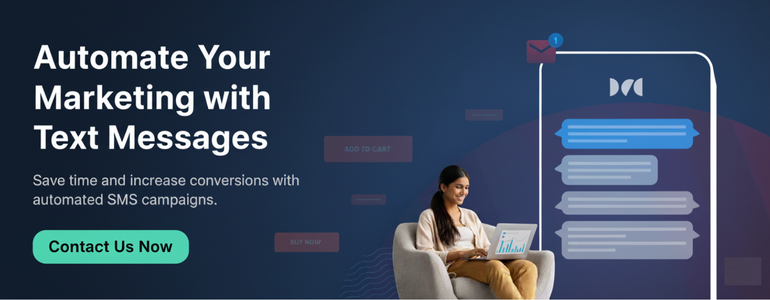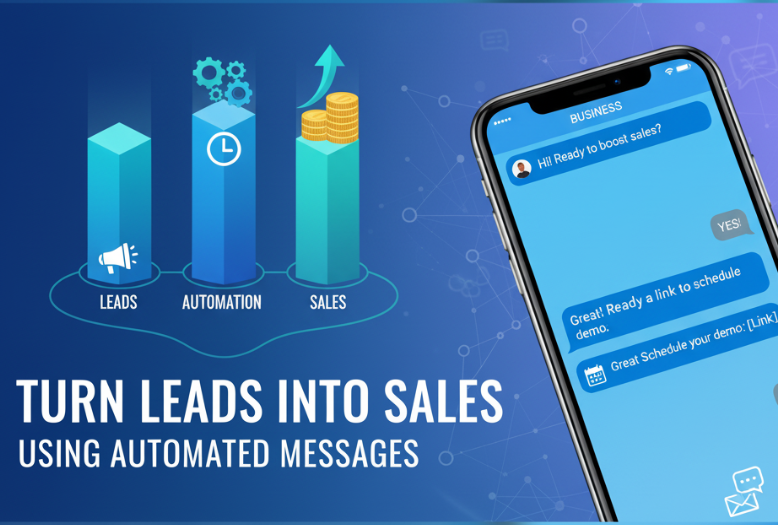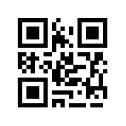Potential customers expect fast and helpful communication. Delays can cost you valuable leads. Automated messages helps businesses respond quickly, provide useful information, and guide prospects toward a purchase. Automation is more than sending bulk messages. It lets you send personalized notes, reminders, and follow ups that feel human while saving time. From welcoming new leads to reminding them about important offers, automation keeps your sales process smooth.
In this article, we will show you how to turn leads into sales using automated messages, share practical tips, and highlight real examples of businesses that have improved conversions with automation.
Understanding Automated Messages
Before diving into the strategy, let’s clarify what automated messaging actually means.
Automated messages are pre-set, rule based messages sent automatically based on specific triggers or customer actions. These could include:
- A welcome message when a visitor subscribes to your email list
- A follow up message after someone downloads your brochure or pricing guide
- A reminder when a customer abandons their shopping cart
- A re-engagement message when a lead hasn’t interacted for a while
Automation ensures that every lead receives the right message at the right time without you lifting a finger.
Why Automation is a Game-Changer for Lead Conversion
Manual follow ups and one-on-one communication are time consuming. They’re also inconsistent, especially when your sales or marketing team is small.
Here’s how automation changes the game:
a) Instant Response Builds Trust: Leads lose interest quickly. According to studies, companies that respond to inquiries within five minutes are nine times more likely to convert leads. Automated messages make this possible.
b) Personalization at Scale: With automation tools, you can personalize messages using the lead’s name, location, or behavior all automatically. It feels human, even though it’s handled by software.
c) Consistent Nurturing: Leads don’t always buy immediately. Automated workflows can nurture them over time through a sequence of follow-up messages, tips, and offers.
d) Saves Time and Effort: Automation reduces the need for manual outreach, freeing your team to focus on closing deals and improving the customer experience.
e) Data-Driven Insights: Automation platforms provide detailed analytics on open rates, clicks, and conversion rates. These insights help you refine your messaging strategy.
The Lead Conversion Journey: Where Automation Fits In
Let’s break down the lead to sale journey and see how automated messaging fits into each stage.
Stage 1: Lead Capture
This is where a visitor becomes a lead by taking action filling out a form, signing up for a newsletter, or requesting a quote.
Automation Example:
- Send a welcome message thanking them for joining.
- Deliver a lead magnet (like an ebook or offer) instantly.
- Introduce your brand briefly and set expectations.
Stage 2: Lead Nurturing
Most leads aren’t ready to buy immediately. They need education, trust building, and reminders.
Automation Example:
- Send a series of educational emails or WhatsApp messages over a few days.
- Share product benefits, testimonials, or success stories.
- Use behavioral triggers for example, if they clicked a pricing page, send a message offering a free consultation.
Stage 3: Lead Conversion
At this stage, the goal is to turn interest into action, a purchase or booking.
Automation Example:
- Send a personalized offer or discount to encourage purchase.
- Use cart abandonment messages if they added a product but didn’t check out.
- Send reminders like: “Your cart is waiting to complete your order in the next 24 hours and get 10% off.
Stage 4: Post Sale Follow Up
Once a customer makes a purchase, the relationship doesn’t end, it evolves.
Automation Example:
- Send a thank you message with purchase details.
- Share a feedback or review link after a few days.
- Send cross-sell or upsell offers based on previous purchases.
Stage 5: Re-Engagement
If a lead or customer goes inactive, an SMS marketing campaign can serve as an effective re-engagement strategy to bring them back. Timely, personalized messages can reignite interest, prompt action, and restore customer relationships with minimal effort.
Automation Example:
- Send “We miss you!” or “New updates just for you!” messages.
- Offer a limited time deal or reward for returning customers.
Channels for Automated Messages
Automation isn’t limited to email anymore. Modern marketing automation tools support multiple communication channels. Here are the most effective ones:
a) Email Automation: Still one of the most powerful channels for nurturing leads. Tools like Mailchimp, HubSpot, and ConvertKit allow you to send automated campaigns and drip sequences.
b) WhatsApp Automation: With over 2 billion users, WhatsApp automation is ideal for instant, personal communication. Businesses use tools like Twilio, WATI, or WhatsApp Business API to send automated welcome messages, reminders, and order updates.
c) SMS Automation: SMS and MMS boast high open rates (over 90%). SMS is ideal for quick reminders, flash sales, or appointment confirmations, while MMS adds visual appeal with images or rich media enhancing engagement where supported.
d) Chatbots and Live Chat: AI-powered chatbots on websites or social media can answer FAQs, qualify leads, and collect contact information 24/7.
e) Social Media Messaging: Platforms like Facebook Messenger and Instagram DMs now support automated replies, helping businesses engage followers instantly.
Building Your Automated Messaging Strategy
Creating an effective automation system requires strategy, not just software. Follow these steps:
Step 1: Identify Key Lead Touchpoints
Map your customer journey. Identify where leads interact with your brand website forms, WhatsApp chats, social media DMs, etc.
Then, set up automation triggers for each stage.
Step 2: Segment Your Leads
Not all leads are the same. Segment them based on:
- Source (organic, ads, referral)
- Behavior (clicked a link, downloaded a file)
- Interests or demographics
Personalized automation increases conversion rates dramatically.
Step 3: Craft Your Message Sequences
Each automated message should have a goal to inform, remind, persuade, or convert.
For example:
- Message 1: Welcome + brand introduction
- Message 2: Share product value or benefits
- Message 3: Send testimonial or success story
- Message 4: Offer discount or free consultation
- Message 5: Reminder or “last chance” message
Keep messages short, conversational, and action oriented.
Step 4: Use Personalization Smartly
Automation doesn’t mean robotics. Use dynamic fields like:
- {{First Name}}
- {{Product Viewed}}
- {{Previous Order}}
Example:
“Hi {{First Name}}, we noticed you were checking out our {{Product Viewed}}. Here’s an exclusive 10% discount just for you!”
Step 5: Set Timing and Frequency
Timing matters. Don’t flood your leads with too many messages.
Best practices:
- Send the first response instantly
- Follow up 24-48 hours later
- Space educational messages every 2-3 days
- Send limited time offers after 7-10 days
Step 6: Measure and Optimize
Monitor:
- Open rates
- Click through rates
- Conversion rates
- Unsubscribe or opt-out rates
Test different message formats, subject lines, and sending times to improve results.
Real Life Examples of Automation in Action
Example 1: E-commerce Store
A shoe brand automates messages like:
- “Welcome! Enjoy 10% off your first order.”
- “You left items in your cart – complete your purchase now.”
- “Your order has shipped! Track it here.”
Result: 35% increase in conversions from abandoned carts.
Example 2: Real Estate Business
A real estate company sets up automated WhatsApp messages for inquiries:
- “Thanks for your interest! Here’s the brochure and pricing details.”
- “Would you like to schedule a free site visit this weekend?”
- “A new project launching soon near your area!”
Result: 50% higher engagement rate from leads.
Example 3: Service Based Business
A home cleaning company automates:
- “Thank you for booking! Our team will arrive at 10 AM.”
- “Please rate our service, it helps us improve.”
- “Refer a friend and get ₹200 off your next cleaning.”
Result: Increased repeat bookings and customer retention.
Best Practices for Using Automated Messages
To make automation work effectively, follow these golden rules:
Keep it Human: Even though it’s automated, make your tone friendly, warm, and helpful.
Add Value in Every Message: Avoid sending messages just for the sake of it. Each communication should inform, solve a problem, or provide an offer.
Respect Privacy: Follow GDPR or local data privacy laws. Always allow users to unsubscribe or opt out.
Test Before Launching: Check links, personalization tags, and triggers to avoid sending broken or wrong messages.
Combine Automation with Human Support: Automation should enhance not replace human communication. Always give users an option to connect with a real person.
Future of Automated Messages
AI and machine learning are making automated messages smarter than ever.
Modern systems can now:
- Predict when a lead is likely to convert
- Send messages at the perfect time
- Analyze sentiment to adjust tone automatically
- Integrate with voice assistants and chatbots
The future of lead conversion will be a blend of AI-driven automation and human empathy, giving customers a truly personalized experience.
Supercharge Your Marketing with Textmunication’s Smart Tools
Connecting with your customers has never been easier. Textmunication is the best SMS marketing platform that helps businesses send messages quickly and effectively. It is perfect for small businesses, online stores, and large companies who want to reach their audience directly through mobile messaging.
Why Choose Textmunication:
- White Label Text Message Marketing: Brand the platform as your own and offer SMS marketing services to your clients without building the technology yourself.
- eCommerce SMS Marketing: Send personalized promotions, order updates, cart reminders, and special offers to increase sales. SMS messages have higher open rates than emails, making your campaigns more effective.
- Automated Messaging: Schedule messages to go out automatically at the right time, saving time while keeping customers engaged.
- Easy to Track: Get clear reports on delivery, opens, and clicks so you can see how well your messages are performing.
- Simple Integration: Works easily with eCommerce platforms, CRMs, and other tools, making setup fast and smooth.
With Textmunication, you can reach more customers, boost sales, and keep your audience engaged without extra effort. Whether you want to grow your online store, offer SMS services to your clients, or just communicate better with your customers, Textmunication makes it simple. Start using Textmunication today and take your marketing to the next level.

Final Thoughts
Automated messaging is no longer optional, it’s a powerful tool that allows businesses to engage leads quickly, nurture relationships consistently, and guide prospects toward making a purchase. By delivering the right message at the right time, you can build trust, provide value, and stay top of mind for potential customers without overwhelming your team.
When implemented strategically, automation not only saves time but also increases conversions and customer loyalty. Combining personalized automated messages with human support ensures that every lead feels valued, creating a seamless journey from initial interest to repeat business. Start leveraging automated messaging today to turn more leads into long-term customers.

